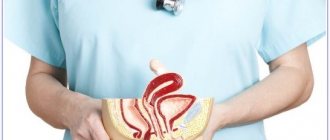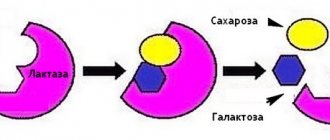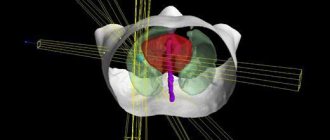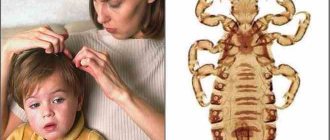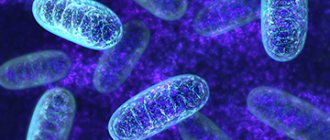Kraurosis of the vulva - what is it?
- proliferation of rough connective tissue;
- hyperkeratosis and atrophy of squamous epithelium.
As a result, deformation develops, the external genitalia become smaller, and their functions are disrupted.
Most often, the disease kraurosis of the vagina and vulva is diagnosed in patients over 45-50 years of age (after the onset of menopause), however, it is possible that it may develop at a younger age. In children, kraurosis of the vulva is a rare occurrence.
Conventionally, the process of development of pathology in gynecology is divided into three stages:
- There is a violation of microcirculation and tissue hypoxia. The result is swelling and redness of the genitals.
- Pigmentation appears. The skin becomes inelastic, dry, rough. Thin white scales form on the mucous membranes. The labia majora and minora are significantly flattened.
- Cicatricial sclerosis and complete atrophy of the external genitalia develop. The sclerosed tissues of the vulva become strongly wrinkled, and the labia minora and majora decrease in size. The vagina, anus and external urethra narrows. At the third stage of vulvar kraurosis, according to reviews of sick women, severe pain occurs during sexual intercourse. The acts of urination and defecation become difficult.
Diagnostic methods
Diagnosis begins from the gynecologist's chair. During the examination, red edematous tissue is detected (at the first stage). As the disease progresses, the labia minora are visually distinguishable, the color of the mucous membrane becomes whitish, it looks thinner, resembling parchment. In the first two stages, the hairy part of the vulva is not affected.
Vulvoscopy helps in diagnosis. It is performed with the same apparatus as colposcopy, but the examination is focused on the surface of the vulva rather than the cervix.
Laboratory diagnostics include examination of smears, as well as blood and urine tests. There may be an increase in glucose levels in diabetes mellitus. Screening for sexually transmitted infections may be recommended. HPV is more important.
During vulvoscopy, a tissue sample is specifically taken for histological examination. This allows you to accurately determine the condition of tissues and their tendency to turn into cancer.
Often, in areas of kraurosis, another type of change is determined - leukoplakia. It has been noted that the transition to cancer occurs due to areas of leukoplakia, and not kraurosis.
Differential diagnosis is more needed in the initial stages. It is necessary to distinguish kraurosis from neurodermatitis, lichen planus, leukoplakia, diabetes mellitus, dysplasia, vulvitis and vaginitis, which may have a similar course.
Causes of kraurosis of the vulva
Kraurosis of the vulva is a pathological reaction of the surface layers of squamous stratified epithelium to the influence of various external and internal factors. Doctors list the causes of the disease as:
- short reproductive period (if a woman has already reached menopause);
- surgical interventions performed on the genitals;
- neuroendocrine diseases (impaired bioelectrical activity of the cerebral cortex, hypofunction of the ovaries, adrenal glands, thyroid gland);
- inflammatory diseases of the vulva (genital herpes, human papillomavirus);
- decreased immune defense;
- prolonged stay in a state of depression, psychosomatic disorders;
- lack of sex life.
Sometimes the disease kraurosis of the vulva and vagina becomes a consequence of a chemical burn.
Factors that provoke gynecological pathology include diabetes mellitus, obesity, and failure to comply with basic personal hygiene rules.
Kraurosis of the vulva is a pathological reaction of the surface layers of squamous stratified epithelium to the influence of various external and internal factors. Doctors list the causes of the disease as:
- short reproductive period (if a woman has already reached menopause);
- surgical interventions performed on the genitals;
- neuroendocrine diseases (impaired bioelectrical activity of the cerebral cortex, hypofunction of the ovaries, adrenal glands, thyroid gland);
- inflammatory diseases of the vulva (genital herpes, human papillomavirus);
- decreased immune defense;
- prolonged stay in a state of depression, psychosomatic disorders;
- lack of sex life.
Sometimes the disease kraurosis of the vulva and vagina becomes a consequence of a chemical burn.
Factors that provoke gynecological pathology include diabetes mellitus, obesity, and failure to comply with basic personal hygiene rules.
The best doctors for the treatment of vulvar kraurosis
9.9 258 reviews Obstetrician Gynecologist Gynecologist-endocrinologist Doctor of the highest category Vera Valerievna Kadohova Experience 15 years Candidate of Medical Sciences Medicine and Beauty on Paveletskaya Moscow, 6th Monetchikovsky lane, 19 10 90 reviews Obstetrician Gynecologist Gynecologist-endocrinologist Doctor of the highest category Khangeldova Karina Grigorievna Experience 28 years Candidate of Medical Sciences Medicine and Beauty on Paveletskaya Moscow, 6th Monetchikovsky lane, 19 10 200 reviews Obstetrician Gynecologist Mammologist Gynecologist-endocrinologist Ultrasound specialist Doctor of the highest category Arnaut Svetlana Ivanovna Experience 28 years Candidate medical sciences Miracle Doctor on Shkolnaya 49 Moscow, st. Shkolnaya, 49 Euromedical clinic Moscow, Sirenevy Boulevard, 32a 9.4 324 reviews Ultrasound specialist Obstetrician Gynecologist Gynecologist-endocrinologist Mammologist Doctor of the highest category Elena Viktorovna Vereshchagina Experience 24 years Health Clinic on Tretyakovskaya Moscow, Klimentovsky lane, no. 6 Premium clinics in Bibirevo, Moscow, st. Pleshcheeva, 11v 9.9 33 reviews Obstetrician Gynecologist Gynecologist-endocrinologist Doctor of the highest category Oksana Viktorovna Bashkirova Experience 33 years Capital Medical Clinic on Sretenka Moscow, st. Sretenka, 9 10 162 reviews Obstetrician Gynecologist Mammologist Gynecologist-endocrinologist Doctor of the highest category Kapustina Inna Vladimirovna Experience 32 years Health Clinic on Tretyakovskaya Moscow, Klimentovsky lane, 6 9.7 92 reviews Obstetrician Gynecologist Doctor of the first category Beda Elena Sergeevna Experience 19 years old Family at the River Station, Moscow, st. Festivalnaya, 4 9.4 9 reviews Obstetrician Gynecologist Doctor of the highest category Bobryshev Yuri Viktorovich Experience 29 years Miracle Doctor on Shkolnaya 49 Moscow, st. Shkolnaya, 49 9.2 13 reviews Obstetrician Gynecologist Ultrasound specialist Akramova Gavhar Saidullaevna Experience 33 years Euromedical clinic 24 Zhulebino Moscow, Lyubertsy, Gorodok B, st. 3rd Post Office, 102 Medical Center On Clinic on the street. Trekhgorny Val Moscow, st. Trekhgorny Val, 12, building 2 Medical center ON CLINIC at the Park of Culture Moscow, Zubovsky Blvd., 35, building 1 9.6 24 reviews Obstetrician Gynecologist Gynecologist-endocrinologist Doctor of the highest category Mosolova Maria Andreevna Experience 20 years Candidate medical sciences Diagnostic center Helix on Vavilova Moscow, Vavilova, 91 k. 1
Causes of the disease:
The causes are currently unknown, but there are several factors that play a large role in the occurrence of the disease.
- Autoimmune
- Endocrine
- Viral
- Infectious
- Psychogenic factors
The leading role in the development of kraurosis and leukoplakia of the vulva can be played by the following factors:
- violation of intimate hygiene rules - very frequent overheating, local (diapers for adults)
- wearing sanitary pads every day all the time
- traumatic disorders of the genital organs obtained either during surgery or injury, chemical exposure (some women like to abuse potassium permanganate for washing)
- early menopause, which indicates severe ovarian hypofunction and a sharp drop in estrogen production
- thyroid diseases
- adrenal glands
- frequent inflammatory diseases of vulvitis and vulvovaginitis
- papillomavirus and herpetic infections lead to damage to the epithelium of the vagina, vulva and cervix
- autoimmune diseases that lead to decreased immunity
- overweight
Symptoms of vulvar kraurosis
The first symptom of vulvar kraurosis is paresthesia - slight tingling in the area of the external genitalia. Also at the initial stage of the disease the following may appear:
- feeling of dryness;
- tightening of the skin of the labia;
- burning sensation in the vagina.
The main symptom of kraurosis of the vagina and vulva is paroxysmal itching, which worsens at night, after physical activity and taking a hot bath. The discomfort is explained by changes occurring in the receptors and disrupting the conduction of nerve impulses. Constant itching of the vulva provokes insomnia, reduces performance, and leads to the development of psycho-emotional and vascular disorders.
Women suffering from kraurosis of the vulva are often concerned about:
- pain that occurs during sexual intercourse and interferes with an active sexual life;
- defecation disorder;
- difficulty urinating (dysuria);
- cracks and scratches, inflammatory lesions of the skin in the genital area.
The development of the pathological process leads to the fact that the labia become swollen and hyperemic. Then the skin becomes rough, the mucous membranes dry out. Pubic hair begins to fall out (this symptom is easy to notice by looking at a photo of vulvar kraurosis). The lumen of the vagina and urethra sharply decreases (sometimes their complete obliteration is observed).
If you notice similar symptoms, consult a doctor immediately. It is easier to prevent a disease than to deal with the consequences.
A little anatomy
The vulva is represented by a strictly separated anatomical zone. It includes:
- labia majora;
- clitoris;
- labia minora;
- vestibule of the vagina;
- hymen.
The epithelium of this area is kept moist by normal vaginal secretions. The tissues of the labia majora have a large layer of subcutaneous tissue, and the labia minora are represented by skin folds. The skin has a large number of estrogen receptors. Hormones determine the condition of the mucous membrane, the microflora of the vagina, and therefore health.
Diagnosis of kraurosis of the vulva
Diagnosis of vulvar kraurosis is not difficult. It is based on laboratory, physical and instrumental examination. The doctor can make the primary diagnosis immediately after examining the patient in the gynecological chair. To assess the nature of pathological changes in the skin and mucous membranes, vulvoscopy is performed - an examination of the external genitalia using an optical device.
With kraurosis in the stage of complete atrophy, no differential diagnosis is carried out. At the first symptoms, the gynecologist excludes a number of diseases:
- lichen planus;
- neurodermatitis;
- vulvitis;
- diabetes;
- leukoplakia;
- dysplasia.
A mandatory diagnostic procedure for the disease is testing for the presence of human papillomavirus using the polymerase chain reaction method. To detect atrophy/atypia and the presence of epithelial cells affected by the virus, a cytological examination (cytology) of smears and impressions from the vulvar mucosa is carried out.
In order to exclude malignancy (development of cancer cells), it is possible to take a biopsy followed by histological examination of the resulting material.
Precautionary measures
Kraurosis is a precancerous disease. You should not rely on traditional medicine alone.
Before using any prescriptions, you should consult your doctor, otherwise you may harm your health.
– a chronic progressive atrophic process of the skin and mucous membrane of the vulva, associated with involutive changes in the external genitalia. Kraurosis of the vulva is accompanied by paresthesia, dryness, itching of the mucous membrane; atrophic and sclerotic changes in the labia minora, clitoris, labia majora; dyspareunia, vulvitis, vaginal stenosis. Kraurosis is diagnosed during an external examination, vulvoscopy, and biopsy of vulvar tissue. Treatment of vulvar kraurosis includes local and general hormonal therapy, physiotherapy, vitamin therapy, and, if indicated, vulvectomy.
How to cure kraurosis of the vulva
Treatment of vulvar kraurosis is quite complex. It requires an integrated and competent approach. Gynecologists focus on conservative therapy - the use of tablets, ointments and suppositories aimed at:
- elimination of symptoms;
- improvement of tissue trophism;
- blocking the inflammatory process;
- elimination of psycho-emotional stress.
Usually the patient is prescribed:
- Antihistamines (Tavegil, Diazolin, Suprastin).
- Sedative tablets (Aminazine, Seduxen).
- Alcohol-novocaine blockade of the pudendal nerve.
- Hormonal ointments, which include estrogens (Premaorin, Estradiol dipropionate, Estriol), androgens, progesterone, corticosteroids.
The treatment regimen for vulvar kraurosis largely depends on age. For women under 40 years of age, estrogen preparations are not recommended. In the second phase of the menstrual cycle, they can use progesterone creams. Elderly patients are often prescribed Sinestrol intramuscularly or Estriol orally, after Norkolut orally or Oxyprogesterone capronate intramuscularly. For severe itching, ointments with androgens help achieve the best results.
Corticosteroid ointments with prednisolone, hydrocortisone, and betamethasone have proven themselves to be quite good in the treatment of kraurosis of the vagina and vulva. They have a stabilizing, desensitizing and anti-inflammatory effect. If a microbial infection is associated with the underlying disease, local antibiotic therapy is indicated.
The disease can also be treated using homeopathy, but this is a very long-term task, so in advanced forms of the disease, gynecologists recommend resorting to more intensive therapy. To start homeopathic treatment, you can take the drug Mercuriussolubilis 6. The recommended dosage is 1 granule outside meals before bed.
Invasive methods and surgery
If conservative treatment methods are ineffective, surgical treatment is performed. In this case, different methods can be used:
- laser ablation (“evaporation” of pathological foci from the affected surface);
- denervation of the vulva (elimination of nerve endings in the tissues of the vulva in order to eliminate pain and itching);
- cryodestruction of affected tissues (“freezing” of lesions).
If there is a suspicion of the development of cancer, a vulvectomy is performed - superficial excision of the skin of the vulva.
Laser therapy for kraurosis of the vulva
When treating kraurosis of the vulva with a laser, forced low-intensity radiation of the light range is used. To eliminate all symptoms, 15 to 30 sessions are needed (ideally, they should be carried out daily).
The effect of a helio-neon laser on the affected tissue can improve the condition of the mucous membranes, normalize blood supply, resolve connective tissue and reduce glycogen levels. Laser therapy may be performed before starting medication. For kraurosis of the vulva, it can be combined with:
- balneological procedures;
- X-ray therapy;
- reflexology;
- photodynamic therapy.
Treatment of kraurosis of the vulva with folk remedies
Traditional medicine is of auxiliary value in case of illness. With their help you can eliminate itching, inflammation and burning.
- Linseed oil. For kraurosis of the vulva, flaxseed oil can be smeared with a cotton pad on the affected tissue 2-3 times a day.
- Baths with pharmaceutical chamomile. The water temperature should be 38-39oC. Brew a glass of dry chamomile with 3 glasses of boiling water. Leave for 30 minutes. Strain. Sit in a bowl of broth.
- Tar soap. Dissolve a spoonful of baking soda in a liter of warm water. Wash with soda solution 2 times a day using tar soap. After the procedure, treat the skin with sea buckthorn oil.
- Celandine. Cut the flowering celandine grass, chop it and place it in a half-liter jar. Pour vodka. Leave for 3-4 days. Apply the resulting tincture to the areas of kraurosis every day. After drying the skin, it is advisable to apply Sinaflan ointment 0.25%.
Any traditional medicine prescription should be agreed with your doctor.
Reasons for the development of vulvar kraurosis: Vulvar kraurosis occurs as an inadequate reaction of the surface layers of stratified squamous epithelium to various changes in a woman’s body.
1. Neuroendocrine disorders are often detected: decreased function of the adrenal cortex, ovaries, thyroid gland, pituitary gland. In most cases, kraurosis occurs during and after menopause, and at a young age - after surgical interventions on the genitals and thyroid gland.
2. It is possible that there are chronic infections of the female sphere and the existence of a long-term persistent infection: human papillomavirus, herpes virus.
3. Often women with this disease suffer from diabetes, excess weight, and other endocrine disorders.
4. An autoimmune mechanism for the development of the disease cannot be ruled out.
5. There are observations that kraurosis has psychosomatic roots, that is, it is the body’s reaction to mental trauma, tension, and stressful situations. More often, kraurosis occurs in women with low mood levels, who often feel depressed and experience strong resentment towards loved ones, towards men, towards the whole world. There is a rejection of one’s feminine side or suppression of one’s sexuality, a feeling of guilt for the emergence of intimate desires.
Quite rarely, when diagnosing “Vulvar kraurosis”, it is possible to establish the exact cause of its occurrence. Recently (over the past year), a significantly larger number of women have been seeking homeopathic treatment with a diagnosis of “Kraurosis”. Throughout the world, this disease is considered incurable, since its genesis is unclear and there are no ready-made recipes or treatment regimens. Hormone therapy and excision of areas of sclerosis provide a temporary effect with subsequent worsening of symptoms. But homeopathy gives us the opportunity not only to alleviate the symptoms (and this is sometimes terrible intolerable itching and burning with pain), but also to cure this painful condition.
Cases of curing kraurosis:
1 case:
On May 31, 13, a woman born in 1965 came to the homeopathic office. with complaints of swelling and redness of the skin in the area of the forearms and the back of the hands, burning and itching of the mucous membranes in the external genital area, which increases in warmth and at night. The redness of the hands, as well as the burning sensation, occurred in June 2012, and is associated with hot weather. Over the past year he has been experiencing an irregular cycle. I contacted a gynecologist. The diagnosis was made: “Climacteric dysfunction. Kraurosis of the vulva." Oral and local hormonal medications were prescribed. I didn’t take hormones; I didn’t use hormonal ointments for long, as they soon stopped relieving the itching and burning. Moreover, hormonal ointments provoked swelling and burning in the genital area. Chamomile decoction and baby cream helped.
Also, recently I have been worried about pain in the knee joints, small joints of the arms and legs, which intensify with physical activity and decrease with rest.
History: sore throat, chronic urticaria, allergy to penicillin antibiotics and household chemicals. Chronic cholecystitis, pancreatitis with periodic exacerbations. Osteochondrosis of the cervicothoracic spine with pain in the neck muscles.
Modalities: Likes cool weather. Trying not to be in the sun in the heat.
Loves sweets, except ice cream. Can't stand the feeling of hunger.
He is rarely thirsty and drinks little liquid.
Laboratory data and levels of female hormones are within the age norm. Blood sugar – 5.8 mmol/l.
On examination: a woman of short stature, heavy build. Dark-haired, dark-eyed. Round pretty face. Feeling of pastiness, bags under the eyes. Fast, talkative, agile, despite her physique. There are dry, flaky areas on the skin of the hands. Heart sounds are muffled. A.D. 130/ 80 mm Hg. Vesicular breathing. Urination is rare. Upon examination, the joints are not deformed, there is slight swelling in the knee area, more on the right, there is no pain on palpation.
During an external examination of the genital organs, swelling of the labia without pronounced redness is noted; on the mucous membrane of the labia majora there are multiple whitish sclerotic areas with separate spots the size of a hazelnut, among which small reddish erosions are visible (apparently damage from scratching).
Based on the constitutional characteristics and set of symptoms, Apis was most suitable . A tendency to allergic reactions, edema in the absence of thirst, a love of coolness, a quick temperament - all this is characteristic of the drug Apis.
The following was prescribed: 1) Apis in increasing potencies: Apis 6 CH, Apis 12 CH, then Apis 30 CH. Topically recommended baby cream and calendula ointment.
In addition, Actaea racemosa was prescribed 6 - 2 times a day daily, as attention was drawn to intolerance to the feeling of hunger with subsequent headache, borderline blood glucose levels, and exacerbations of chronic disease. history of pancreatitis, articular syndrome with pain when walking up stairs, menopausal complaints, cervical osteochondrosis with pain in the neck muscles.
Repeated appointment on September 27, 2013 (after 4 months):
She took homeopathic medicines for 4 months. The allergic spots on my hands gradually disappeared. Upon examination, the skin is clean and smooth. The feeling of hunger is less pronounced, thirst has appeared, and urination is more frequent.
No burning or itching in the genitals. It became much easier to walk and go down stairs. There is no pain in the joints; on examination there is no edema, pain, or swelling of the joints.
Examination of the external genitalia: There is no swelling of the lips, the whitish areas on the mucous membrane begin to turn pink, the tissue, instead of sclerotic, is replaced by ordinary epithelium and becomes pink. A few white spots remained, but much smaller in size - about the size of a lentil grain.
Prescriptions: Apis 30 and Actaea racemosa 12.
Repeated appointment on January 23, 2014 (after another 3 months):
Burning and itching do not bother me. Upon examination, the mucous membrane of the labia is pink, 2 paler areas in place of whitish spots are barely visible.
In November I noticed the return of my periods. Before this I had not had my period for several months.
From other organs: the joints do not bother. Notes crunching in joints when walking up stairs. Blood sugar returned to normal: 4.8 mmol/l.
The appointments are the same.
The last meeting took place on March 20, 2014. He makes no complaints. I had my period again at the beginning of March, scanty and painless. On external examination, the mucous membranes of the labia are pink, there is no swelling, or sclerotically changed areas. On March 18, she visited the gynecologist again, the diagnosis of “Climacteric dysfunction” was left, the diagnosis of “Vulvar kraurosis” was removed, observation was recommended.
What helped? First of all, of course, Apis.
Apis is a preparation from the body of a bee.
In homeopathy, this is one of the best remedies for treating urticaria with severe swelling, itching, and burning. It helps with various allergic conditions, including bronchial asthma. Apis is best suited for cheerful, active people who work “like bees.” It’s not difficult to recognize such a person; once you see him, you remember him forever!
They like coolness, in the heat their limbs and face swell, “bags” form under their eyes, eczema and allergic diseases worsen. On the part of internal organs, there is often cystic degeneration of organs - in the thyroid gland, in the kidneys, in the ovaries.
The second drug - Actaea racemosa ( Cosimicifuga ) in this case helped to level out the hormonal levels, according to both homeopaths and herbalists - this is one of the best plants - sources of phytoestrogens.
Cohosh (black cohosh) - a plant from the buttercup family with an elegant inflorescence in the form of a tall silvery candle received its name for a reason - its leaves have an extremely pronounced specific odor that drives away insects
Cohosh extract has a proven pharmacological effect: estrogen-like effect, sedative properties, positive effect on the autonomic nervous system, and is part of the drugs Klimadinon, Tsi-klim, Klimaxan, which are used for severe menopausal syndrome.
Case 2
A woman, born in 1962, applied: January 15, 13 to a homeopathic office with D-z: “Kraurosis of the vulva,” this diagnosis was determined in 2010 during a medical examination. This disease coincided with the onset of menopause, when menstruation became irregular. The gynecologist prescribed femaston, my periods were regular for 2 years, but the itching and erosions on the labia mucosa continued to bother me.
At the time of examination, complaints of itching in the area of the external genitalia, which occur day and night, regardless of anything, spontaneously. Along with the itching, small ulcers appear on the mucous membrane, which are very painful when urinating, “as if corroded by acid.”
Washing with infusion of chamomile and calendula helps.
In the anamnesis : in childhood I suffered from chickenpox and pneumonia. As a teenager, I often suffered from bronchitis. Suffers from chronic sinusitis, exacerbations 1-2 times a year with copious purulent discharge.
Gynecological history: Menstruation has always been heavy, especially in the premenopausal period (after 40 years). She periodically took contraceptives. Sexual life since the age of 20, regular until now.
Modalities: Likes medium temperatures. Loves hot tea. Loves salted fish, vegetables, fruits. Does not like loud, sharp sounds, gets scared and flinches.
On examination: a tall woman, well-fed, but not overweight. Blonde hair, blue eyes. The skin is thin and light. Tissue turgor is reduced, the upper eyelids are pasty. The venous pattern is not clearly expressed on the legs, swelling of the legs. There are no features from other systems and organs.
An external examination of the genital organs reveals a slight reduction in the labia with moderate redness of the labia mucosa. The mucous membrane is as if deformed by white shiny strips of connective tissue, sclerotic areas alternate with small reddish erosions the size of a cranberry, the erosions have a clear rounded geometric shape.
Taking into account the characteristic appearance of the patient (delicate skin, decreased tissue turgor, the nature of damage to the mucous membranes, swelling of the upper eyelids and legs, a history of chronic sinusitis, an addiction to salted fish and beer, which she was embarrassed to admit), Potassium bichromicum, CH 6, was prescribed. CH 12, CH 30, taken in increasing potencies for 1 month.
Swelling of the upper eyelids, characteristic of potassium preparations
Repeated appointment after 4 months:
Burning and itching in the genitals are practically not a concern; itching occurs very rarely.
Examination of the external genitalia: some reduction of the labia remains. Upon examination, the mucous membrane of the labia is pink, there are no erosions or damage. Along the edges of the mucosa, at the junction of the mucosa and the skin, there are barely noticeable whitish stripes.
During the homeopathic treatment I did not get sick, there was no sinusitis. I had 2 periods, painless and shorter periods. Occasionally I was bothered by hot flashes and a feeling of heat.
The following prescriptions: 1) Potassium bichromicum 30 in rare doses.
Repeated appointment on November 12, 2013, after 6 months:
She has no complaints and is not bothered by burning or itching in the genitals. I was examined by a gynecologist and had pap smears. The diagnosis of “Vulvar kraurosis” has been removed.
Constitution most suitable for potassium
Thus, both cases demonstrate a clear relationship between hormonal changes and the resulting pathology, and also show the striking constitutional characteristics of women who helped choose the right homeopathic medicines, through which a cure was achieved.
How does laser treatment affect kraurosis?
In this case, the laser beam is “capable” of many things: stopping atrophic processes and restoring elasticity to the affected areas of the vulva, eliminating itching and redness, and restoring blood flow.
In general, the introduction of laser technologies into gynecological practice makes it possible to give very encouraging prognoses for leukoplakia and kraurosis, the treatment of which was a big question a decade ago. Today it has become possible not only to achieve positive dynamics, but also to completely restore the external genitalia, their skin and mucous membranes.
The main thing is that all laser manipulations are performed by an experienced specialist who has extensive practical experience and thoroughly knows how to treat kraurosis in women. Reviews from our patients indicate a high level of professionalism of specialists and that the DECA clinic provides real help even with complex clinical pictures (for example, the course of kraurosis is aggravated by the presence of other genitourinary diseases).
Drugs for treatment
Treatment of leukoplakia and kraurosis is aimed at improving nutrition or tissue trophism, relieving itching and psycho-emotional stress.
- Antihistamines Dibazol Tavegil, Suprastin, Zyrtec and others are prescribed.
- Calming and sedative drugs: Novopassit, Persen, Afobazol, Negrustin, Phenibut are the safest sedatives. Your doctor will prescribe stronger tranquilizers and antidepressants if necessary.
- Local treatment includes hormonal ointments and creams that contain estrogens: Ovestin cream (for any age), Estradiol (preferably for younger people) and progesterone. Ointments with corticosteroids Sinaflan, Flucinar, Hydrocortisone, Prednisolone. Glucocortide ointments are the main drugs for the treatment of itching in kraurosis and leukoplakia. They reduce sensitivity to histamine and serotonin, reduce the synthesis of inflammatory mediators, reduce capillary permeability and reduce the inflammatory response and edema.
- Laser treatment . Treatment is carried out locally; when exposed to laser, tissue trophism and blood supply improve. A fairly effective method, but as part of complex therapy.
- Ozone treatment . Do ozone baths. Another option is to take 200 ml of good refined olive oil and ozonize it. After this, rub into the affected area 2-3 times a day for a long time, up to a year.
- Surgical methods - cryotherapy, laser ablation, vulvectomy . We will not consider these methods in detail, because... They are more traumatic, performed in extreme cases and have many complications.
- Intimate plastic surgery, the introduction of fillers into the area of the labia minora and majora with lichen sclerosus (leukoplakia), into the tissue of the entrance to the vagina - a new and very promising method.
Individual treatment of kraurosis at the DECA clinic
Our experienced gynecologists approach each clinical situation individually - an individual treatment regimen for the disease is developed for absolutely each patient, including laser and drug therapy. The laser equipment of the clinic is a whole set of the most modern devices that are indispensable assistants in the fight to restore women's beauty and health.
Nutrition plays a huge role in obtaining positive results in the treatment of kraurosis: all foods that can cause increased itching, as well as coffee and alcohol, are excluded. Your doctor will tell you more about nutrition during a personal consultation. What else is important? It is important to maintain personal hygiene, avoid wearing tight underwear, and eliminate worries and stress.
Remember that kraurosis of the vulva and leukoplakia of the female genital organs are far from a death sentence! But these are precancerous conditions, the treatment of which must be treated with the utmost responsibility. If you intend to undergo a course of effective treatment that will give positive results, contact the specialists of our clinic! At the first appointment, the doctor will make a diagnosis, offer options (yes, in many cases options are possible!) of treatment, and show in photos what results can be achieved.
On average, a course of treatment for kraurosis costs about 25,000-30,000 rubles (the so-called “turnkey” format). The cost specifically in your case will be announced at a consultation after examination and determination of treatment tactics. Waiting for you!
Causes and phytocorrection of kraurosis
Immunosuppression: Aralia, Rhodiola rosea, Eleutherococcus
Inflammation: macleia, sophora, celandine, eucalyptus
Allergic component: yarrow, tricolor violet, horsetail
Hormonal changes: grasshopper, clover, alfalfa, licorice, hops
Increased thrombus formation: astragalus, sweet clover, chestnut
Excessive fibrosis process: mistletoe, cucumber, chitosan, celandine
Increased vascular permeability: astragalus, lungwort, sophora, yarrow
Trophic disturbances: arnica, St. John's wort, calendula, larch
A number of herbal remedies with anti-sclerotic effects are used: piaskledin from soybeans, piaskledin-300 - Russian medicine, madecassol from Asian centella - world medicine. However, these drugs, as our practical experience shows, do not have independent significance in the treatment of kraurosis.
The inclusion in the therapy of kraurosis of plants with an increased amount of silicon, a microelement actively involved in the formation of connective tissue, is pathogenetically justified. We recommend using horsetail, creeping wheatgrass, agrimony, lungwort, woolly-flowered astragalus, and comfrey.
Phytoapplications with the juice of strawberries, viburnum, cranberries, pomegranate, yarrow, quince, and chokeberry are effective for kraurosis.
Medicinal plants with anti-sclerotic effects are in demand: cinnamon rosehip, garlic, horsetail, tricolor violet, hazelnut and walnut, shepherd's purse, mistletoe, dandelion, calendula officinalis, onion, watercress, nettle, chestnut, birch drooping, Dioscorea nipponensis, barberry, quince.
The role of kraurosis as a prognostic factor in the development of vulvar cancer can be determined by observing the process of cell transformation. Let us list the stages of cell transformation in vulvar cancer and phytocorrection of the process:
immunosuppression - phytoimmunomodulators, menopause - lemon balm, mint, motherwort, hypoestrogenia - clover, alfalfa, trifoli, atrophy - dioscorea, sophora, tribulus, trophic disorders - arnica, astragalus, licorice, proliferation - mistletoe, wormwood, celandine, Ca in situ - fireweed , burrower, comfrey.
We recommend the following treatment regimen for kraurosis.
Collection (g):
Pour 1 teaspoon of the plant mixture into 1 glass of boiling water, leave for 1 hour, then strain and drink in two doses throughout the day. The course of treatment is 1-2 months.
As an immunostimulating agent, we recommend 40 drops of Eleutherococcus extract in the morning and afternoon before meals, and so on for 30 days.
Deoxyribonuclease 50 mg daily intramuscularly in a 0.9% sodium chloride solution (20-30 injections).
Multivitamin preparations: holosas 1 teaspoon 3 times a day; diquertin 2 tablets 3 times a day with ascorutin; safinor 1 tablet in general therapeutic doses.
Electrophoresis on the lesions with a rotokan daily from the cathode.
Bee stings: 1 bee per center, and so on for 15-20 days.
Rubbing into 2-3 areas of apizarthron 2 times a day.
Chitokor 1 tablet 2-3 times a day with meals, and so on for 2 weeks (a drug containing soluble low-molecular chitosan - a compound with anti-inflammatory, antimicrobial, sorption effects).
Phytodietetic recommendations: pumpkin, raisins, dried apricots, apricots, dried fruit compotes, baked apples, potatoes. Salads with added vegetable oil and soy products are very useful.
Share link:
Innovative methods of combating the disease - dual therapy
Medicine has been asking the question for many years: how to treat kraurosis in women; reviews on this matter are very different. Traditional methods include medication, surgery and modern minimally invasive interventions. Any experienced doctor will say that these methods never work alone; therapy always requires an integrated approach, this is the only way to achieve success.
When developing a program, it is very important to take into account not only the stage of the inflammatory process, but also the individual characteristics of the patient, the presence of concomitant diseases, contraindications (they are determined during a conversation with the patient and diagnosis, all of this can be done with us).
In "El.En." Treatment of kraurosis in women is carried out according to a comprehensive program:
- drug therapy (taking special medications);
- laser treatment (treatment of affected areas).
Practice shows that this is the most effective method; it makes it possible to relieve signs of the disease and stop its development. Laser ablation is especially recommended if there is no result from conservative methods (the problem cannot be solved with pills alone).
Benefits of using a laser
Laser exposure has a positive effect on the condition of the skin and vaginal mucosa. Here are just some of the actions performed by a medical laser:
- destruction of damaged areas of the skin and mucous membranes;
- elimination of burning, swelling and redness;
- restoration of normal blood circulation;
- activation of the immune system and restoration of tissue functions.
In combination with properly selected drug therapy, this effect leads to a very powerful effect. The laser reduces the number of pathological foci of keratinization and restores normal vaginal functions. The signs of the disease go away, the patient begins to feel better, he is no longer bothered by difficulty urinating and pain during intimacy.
Kraurosis in men
A fairly rare case, but sometimes men also suffer from inflammation that affects the foreskin and head of the penis. This is very unpleasant and painful. During the pathological process, the surface of the affected areas loses elasticity and wrinkles, and the color of the skin almost always changes.
The scheme is the same - first a consultation, if necessary, tests and a diagnostic examination, after which the specialist will prescribe a combination of a laser and a medication program.
Who is at risk
There is no consensus on what the causes of vulvar kraurosis are. This is due to the fact that pathology can be detected in women of different ages. But more often those who have crossed the threshold of menopause are at risk. There are several main factors that lead to pathology.
- Climax. A decrease in the functional activity of the ovaries leads to a decrease in estrogens. In the epithelium of the vulva, a sufficient amount of glycogen does not accumulate, it becomes thinner, and atrophy develops. The processes are especially pronounced after 60 years.
- Neuroendocrine disorders. In many women, the pathological process develops against the background of decreased activity of many endocrine organs: pancreas, ovaries, thyroid gland. Also, the pathology often accompanies diabetes mellitus and obesity.
- Infections. The connection with the development of kraurosis is relative. There is no reliable data prescribing pathogens to develop kraurosis. But the frequent presence of trichomonas, herpes viruses, papilloma, as well as nonspecific infections has been noticed. Some scientists say that the addition of the infectious process is secondary: in the vulva area, the environment changes from acidic to alkaline. Preconditions for infection are created.
- Local damage. Frequent pathological processes that lead to damage to the surface of the vulva can cause kraurosis. For example, chronic burns from undissolved potassium permanganate crystals, as well as the use of other chemicals. Sometimes at a young age, kraurosis becomes a consequence of surgery on the genital organs.
- Hygiene. There is a connection between the lack of hygiene of the external genitalia and the development of atrophic processes.
- Psychosomatics. The appearance of kraurosis is observed in women who are dissatisfied with themselves, prone to depression, and with problems in the sexual sphere. The development mechanism is associated with a violation of impulse transmission in a certain area of the brain, which is also associated with autonomic regulation. In this case, blood flow to the vulvar mucosa is disrupted, which leads to atrophy.
Often the pathology accompanies other oncological diseases associated with impaired blood flow and lymph circulation:
- lymphoma;
- blood leukemia;
- myelodysplastic syndrome;
- multiple myeloma.
In this case, kraurosis is considered as an additional symptom of the underlying disease.
Impressive results - the disease disappears after several procedures
Despite the difficulty of dealing with a disease such as vulvar kraurosis, treatment using advanced techniques leads to the desired results:
- the affected areas restore lost elasticity;
- tissue nutrition improves;
- destruction of pathological formations occurs;
- compacted areas resolve, wounds heal.
As a result, after completing the full course, the patient gets rid of the main symptoms and begins to feel much better. The person’s sleep normalizes, the itching goes away, he returns to his normal rhythm, in particular, he again gets the opportunity to lead a full intimate life.
The duration of the course is determined by a specialist, based on diagnostic and analytical data, the severity of inflammation and the individual characteristics of the patient. Sometimes just one session is enough to feel the first significant positive changes.
Prevention is the key to recovery!
After completing the full course, the patient must follow certain recommendations. This is important; preventive measures will help enhance the effect and finally defeat a serious and unpleasant illness. Basic recommendations: observing the rules of intimate hygiene, giving up alcohol and smoking, timely elimination of hormonal and endocrine problems. Try to avoid frequent stress and psychological disorders, and stop wearing synthetic underwear.
Why is it necessary to treat kraurosis at the El.En clinic? What do we offer?
In "El.En." European-level service awaits you; we have modern equipment from DEKA (Italy), a leading supplier of laser devices for world laser surgery centers and clinics. We employ gynecologists and surgeons with international authority and the highest qualifications. We have already helped hundreds of women get rid of severe pathology and return to a full life, using the safest and most innovative methods.
The cost of the course is from 25,000 rubles. This is a turnkey price. The doctor will give you the exact prices during your consultation, when he will examine you and prescribe a suitable program. In "El.En." You can undergo all the necessary diagnostic examinations and tests to make a diagnosis.
If you have signs of the disease or this diagnosis has already been made, come to us. Trust the best doctors to solve your sensitive medical problems. Sign up for a consultation through the website or call us at the numbers provided.

